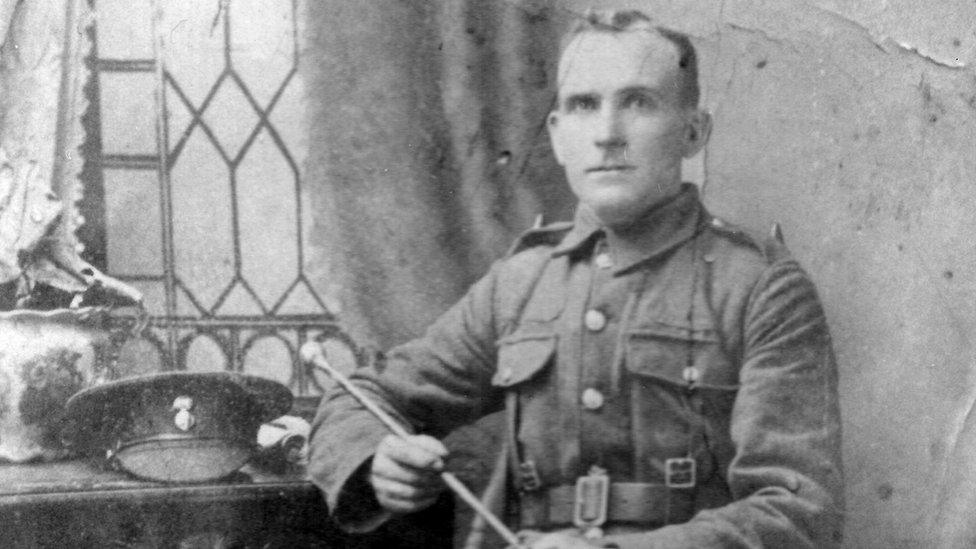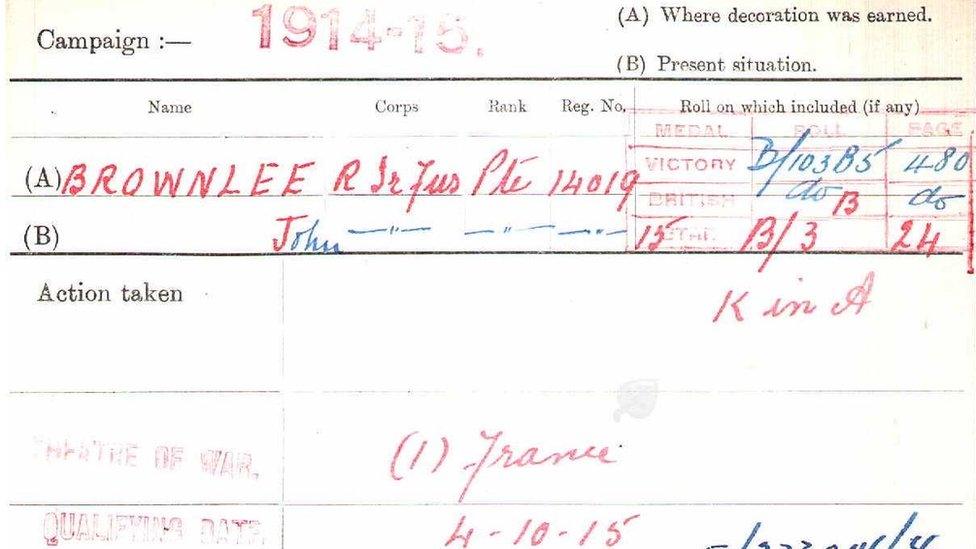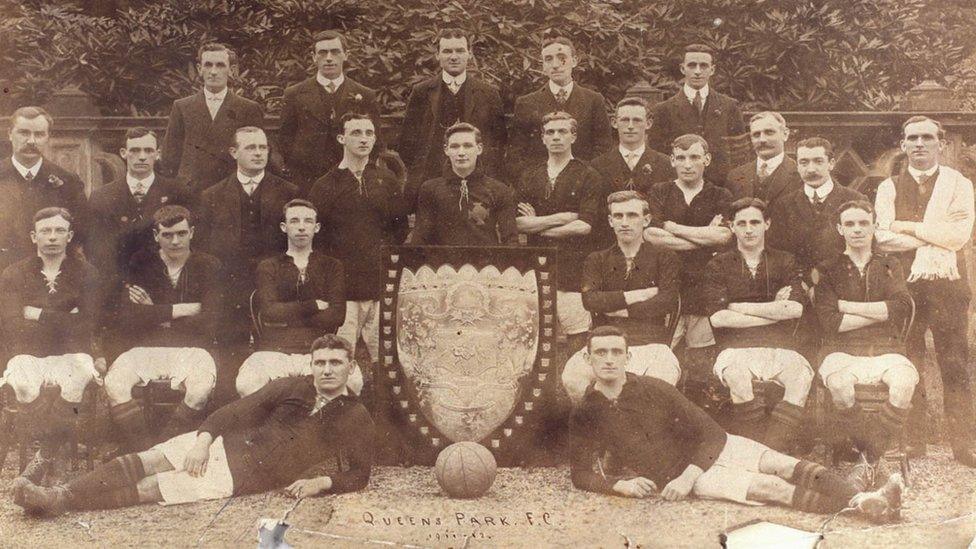World War One: Somme soldier's medals issued more than 100 years later
- Published

More than a century on, my family has received something special: an overdue delivery of Pip, Squeak and Wilfred.
Otherwise known as the 1914-15 Star, the British War Medal and the Victory Medal, each was issued to thousands of soldiers after World War One.
Some remain proudly displayed on descendants' walls, but many have been lost to attics or history as memories faded.
We assumed the latter had happened to my great-great-grandfather's medals - until recently.
'Medals to be disposed of'
Pte John Brownlee was a soldier with 9th Battalion Royal Irish Fusiliers, serving at Beaumont Hamel in France.
A Bangalore torpedo specialist, who worked to clear obstacles such as barbed wire, he was killed in action at the Battle of the Somme on 1 July 1916.
He left behind a widow and six children in Lurgan, County Armagh.
Despite a belief that his medals had been lost over the decades, a curious note on the reverse side of his medal index card suggested something different.

Pte John Brownlee was a Bangalore torpedo specialist with the Royal Irish Fusiliers
In red ink, it explained an official Army request for authorisation "to dispose of medals", dated January 1922.
This suggested they had existed but were never kept in the possession of the family. We may never know why.
The Ministry of Defence (MoD) highlights that all World War One medals were sent to the recipient or next of kin after the war had ended.
Today, its medal office does not provide replacements and directs people who want replicas to contact a medal dealer.

On the reverse of this medal card is a note which suggests the medals were to be "disposed of"
It will, however, authorise the issuing of original medals for a World War One soldier if there is proof they had been returned.
BBC News NI has been told that 73 such sets of medals have been issued since 1 January 2020.
Asked about John Brownlee's case, an MoD spokesperson explained: "The medals would only have been marked as destroyed if they had been officially returned to the MoD.
"Since the medals were definitely no longer in circulation - and official documentation, by way of the Medal Index Card, also confirmed this - we were able to reissue the medals as the originals."
John Brownlee's medals arrived in March, in three small black boxes, each bearing the symbol of a crown in gold, along with a letter from the MoD.
Some 107 years after his death, his record has been updated to show that his medals have been struck and issued to his family.
Naturally in a more pristine condition than many of the century-old issues, they bear his name on the rim along with his identification number - 14019.
BBC News NI looks at the numbers behind the Battle of the Somme
Due to the passing of time and the evidence needed to apply, it is possible there will not be many more original medals issued from a conflict which claimed the lives of millions.
Pip, Squeak and Wilfred - for those who are not familiar - were cartoon characters from the Daily Mirror whose names became synonymous with the medals at that time.
Among the missing
Little information was passed on in my family about John Brownlee.
It is thought his son Ernest, aged five when his father died, kept a photograph of a soldier at his house in Sandy Row, Belfast.
Another relative told me John, his grandfather, had been a football coach before the war and they recalled a team photograph with John stood at the side with a white towel draped over his shoulder.
Based on this, I searched far and wide until I found a photograph that fitted the bill - and there he was staring back, arms crossed, as part of the trophy-winning Queen's Park FC in Lurgan in 1912.
We have since gathered that John Brownlee was also an engine driver in the town, a member of the Orange Order and a signatory to the Ulster Covenant.

John Brownlee, pictured far right with a towel over his shoulder, was a coach for Queen's Park in Lurgan
There is no grave to visit for my great-great-grandfather. Along with 72,000 other names he is remembered on the Thiepval Memorial to the Missing, close to the frontline of the Battle of the Somme.
My father and I have been to visit and, to mark the centenary of Armistice Day in 2018, I read a poem at the memorial which had been written by John Brownlee's widow, my great-great-grandmother, Frances.
Published in the Lurgan Mail newspaper on 2 September 1916, it begins: "I mourn the loss of my husband so dear; so good, so kind, so brave; who died on the battlefield in France, and lies in a hero's grave."

Pte Brownlee's name appears on the Thiepval Memorial in France
In a separate newspaper tribute, the secretary of Loyal Orange Lodge 524, F.A. Monroe, wrote that Pte Brownlee had "innumerable friends" and his "kindly and genial good nature will be missed by all".
"We all hoped when we heard of him being missing that he had been taken prisoner, but alas! he paid the greatest price a man can do for his country," he added.
Receiving the medals feels like a conclusion to John Brownlee's story.
He can now be remembered by future generations through the medals he earned, all thanks to finding that sentence written in red ink.
Related topics
- Published17 July 2024
